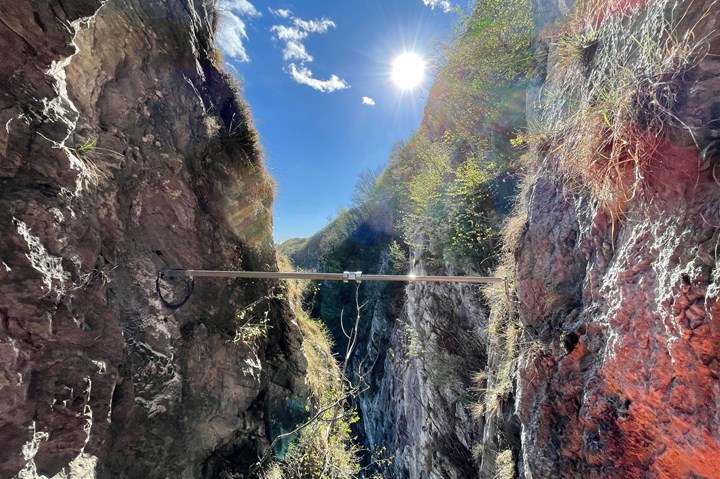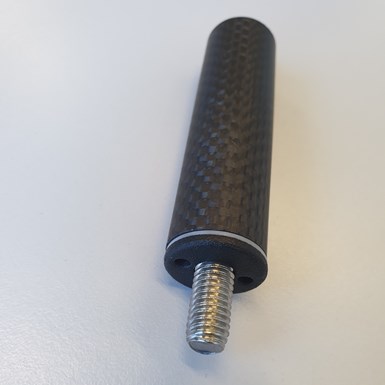Scheurer Swiss commissions composite geo-alarm system to detect natural disasters
Carbon fiber-reinforced 3D printed inserts with glass fiber insulation are bonded to carbon tubes with fast-cure epoxy. The alarm system itself is mounted in areas like rock crevices to detect vibration and movement.

The AarteLink geo-sensor is mounted between two rock crevices to detect vibration and movement. Photo Credit, all images: Scheurer Swiss
Swiss sensor and digitalization professional Aartesys AG (Biel) has commissioned Scheurer Swiss GmbH (Volketswil, Switzerland), a company with more thirty years of experience in lightweight construction for Formula 1, and an unnamed company specializing in the production of round profiles made from carbon and glass fiber, to design and manufacture custom carbon fiber-reinforced thread inserts for its geo-sensor system, AarteLink. The alarm is used for monitoring and alerting individuals early in the event of natural hazards such as rockfalls, avalanches, landslides and floods, all of which are major threats in Switzerland. In particular, the geo-sensor was to be used for Aartesys’ latest protection project on Monte San Salvatore.
Scheurer Swiss notes that when natural hazard events occur, action must be taken quickly. It was of utmost importance then, to develop a geo-sensor system that immediately detects and accurately measures vibrations and movements in all directions, independent of vegetation and weather conditions, while also being simple to install — even in hard-to-reach areas, such as rock crevices. Further, the need for something small, lightweight and easily transportable, yet stable against high-temperature fluctuations common in mountainous regions, and highly precise were central to the solution. Carbon fiber helped meet all of these requirements.

Carbon fiber 3D-printed thread inserts.
The low-maintenance, robust geo-alarm system combines sensor technology, sophisticated electronics and telecommunications technology, according to Scheurer Swiss. The unnamed company supplied the carbon tubes for crack monitoring, which immediately record and precisely measure vibrations as well as changes at critical rock crevices. Scheurer Swiss is responsible for the carbon fiber-reinforced threaded inserts with glass fiber insulation, and an injection bonding system based on fast-curing epoxy, with which the threaded inserts can be fixed in the carbon tubes on both sides within a few minutes and mounted on the rock at a height of several hundred meters.
Further, to manufacture the threaded inserts, Scheurer Swiss incorporated additive manufacturing (AM). “Carbon fiber-reinforced 3D printing meets all the criteria of producing one-of-a-kind items like these custom threaded inserts, which need to be lightweight yet strong, and as cost effective as possible to produce when needed” says Dominik Scheurer, fiber composite and lightweight construction expert at Scheurer Swiss GmbH.
For the present Aartesys project on Monte San Salvatore in Ticino, Switzerland, the supplied carbon tubes are cut to the required length at Scheurer Swiss and fitted with the carbon fiber-reinforced thread inserts before being installed in the rock faces. If required, the carbon measuring tubes can also be cut to length and bonded directly on site. For this purpose, Scheurer Swiss has designed a customized hand tool — a sageblade which serves to help cap the carbon tubes — and prepared a manual tool for professional cutting and gluing.
“With the help of the specially developed and fast-curing injection adhesive, the fitters succeed in gluing the carbon fiber-reinforced threaded inserts into the carbon tubes, which were previously cut to length by hand, even at dizzying heights,” adds Scheurer, engineer and owner of Scheurer Swiss GmbH.
To ensure the final product met all criteria, Aartesys also subjected the stability of the thread inserts and the resistance of the bonding mechanism to a rigorous mechanical stress test. Martin von Känel, CEO of Aartesys AG, notes his satisfaction: “The thread inserts with the epoxy bonding system prove their high reliability and easily withstand a tensile test of up to 400 kilograms. The positive result of our load test clearly shows the expert choice of materials and testifies to successful Swiss engineering.”
Related Content
Cycling forward with bike frame materials and processes
Fine-tuning of conventional materials and processes characterizes today’s CFRP bicycle frame manufacturing, whether in the large factories of Asia or at reshored facilities in North America and Europe. Thermoplastic resins and automated processes are on the horizon, though likely years away from high-volume production levels.
Read MoreComposites manufacturing for general aviation aircraft
General aviation, certified and experimental, has increasingly embraced composites over the decades, a path further driven by leveraged innovation in materials and processes and the evolving AAM market.
Read MorePlant tour: Joby Aviation, Marina, Calif., U.S.
As the advanced air mobility market begins to take shape, market leader Joby Aviation works to industrialize composites manufacturing for its first-generation, composites-intensive, all-electric air taxi.
Read MoreComposites enable epic interior for Museum of the Future
For this one-of-a-kind lobby, AFI pioneered digital, reconfigurable molds to achieve organic-shaped, multifunctional panels and stairwell cladding.
Read MoreRead Next
CW’s 2024 Top Shops survey offers new approach to benchmarking
Respondents that complete the survey by April 30, 2024, have the chance to be recognized as an honoree.
Read MoreComposites end markets: Energy (2024)
Composites are used widely in oil/gas, wind and other renewable energy applications. Despite market challenges, growth potential and innovation for composites continue.
Read MoreFrom the CW Archives: The tale of the thermoplastic cryotank
In 2006, guest columnist Bob Hartunian related the story of his efforts two decades prior, while at McDonnell Douglas, to develop a thermoplastic composite crytank for hydrogen storage. He learned a lot of lessons.
Read More


























